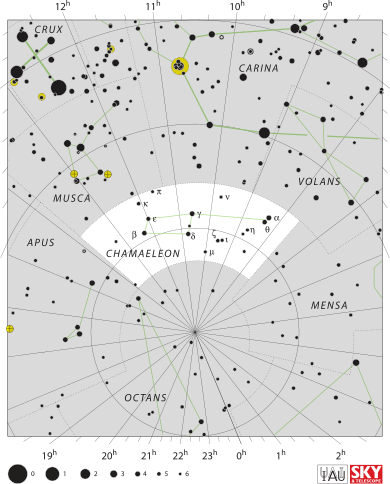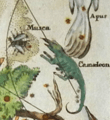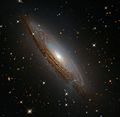Chamaeleon facts for kids
| Constellation | |

List of stars in Chamaeleon
|
|
| Abbreviation | Cha |
|---|---|
| Genitive | Chamaeleontis |
| Pronunciation | genitive |
| Symbolism | the Chameleon |
| Right ascension | 07h 26m 36.5075s–13h 56m 26.6661s |
| Declination | -75.2899170°–-83.1200714° |
| Area | 132 sq. deg. (79th) |
| Main stars | 3 |
| Bayer/Flamsteed stars |
16 |
| Stars with planets | 1 |
| Stars brighter than 3.00m | 0 |
| Stars within 10.00 pc (32.62 ly) | 0 |
| Brightest star | α Cha (4.05m) |
| Messier objects | 0 |
| Meteor showers | None |
| Bordering constellations |
Musca Carina Volans Mensa Octans Apus |
| Visible at latitudes between +0° and −90°. Best visible at 21:00 (9 p.m.) during the month of April. |
|
The Chamaeleon (pronounced "ka-MEEL-ee-on") is a small constellation found in the southern sky. Its name means "the Chameleon" in Latin. This constellation looks like the small lizard known for changing its color.
Chamaeleon is one of the 12 constellations created by Dutch navigators Pieter Dirkszoon Keyser and Frederick de Houtman. They mapped the southern sky during their travels in the late 16th century. The constellation was first shown on a celestial globe by Petrus Plancius in 1597.
Contents
Finding Chamaeleon
The Chamaeleon constellation is quite small. It ranks as the 79th largest constellation in the sky. It covers an area of 132 square degrees. You can only see it from the Southern Hemisphere. It is best viewed in April.
This constellation is surrounded by several other southern constellations:
- Musca (The Fly)
- Carina (The Keel)
- Volans (The Flying Fish)
- Mensa (The Table Mountain)
- Octans (The Octant)
- Apus (The Bird-of-Paradise)
Stars of Chamaeleon
Even though Chamaeleon is small, it has some interesting stars. The brightest star in this constellation is called Alpha Chamaeleontis (α Cha). It is a blue-white star located about 63.45 light-years from Earth.
Chamaeleon has three main stars that make up its shape. Scientists have also found one star in this constellation that has a planet orbiting it. This means there might be other worlds out there in the Chamaeleon constellation!
Deep-Sky Objects
While Chamaeleon doesn't have any famous Messier objects, it is home to some fascinating deep-sky objects. These include areas where new stars are forming.
Chamaeleon Molecular Clouds
One of the most important features in Chamaeleon is its group of molecular clouds. These are huge, cold clouds of gas and dust. They are perfect places for new stars to be born.
- The Chamaeleon clouds are divided into three main parts: Chamaeleon I, Chamaeleon II, and Chamaeleon III.
- Chamaeleon I is the most active star-forming region. It contains many young stars. Some of these stars are still surrounded by disks of gas and dust. These disks might be forming new planets.
- Scientists study these clouds to learn more about how stars and planetary systems begin.
Images for kids
-
The constellation Camaeleon (Chamaeleon) as depicted in Johann Gabriel Doppelmayr's Atlas Coelestis, around 1742.
See also
 In Spanish: Chamaeleon para niños
In Spanish: Chamaeleon para niños



